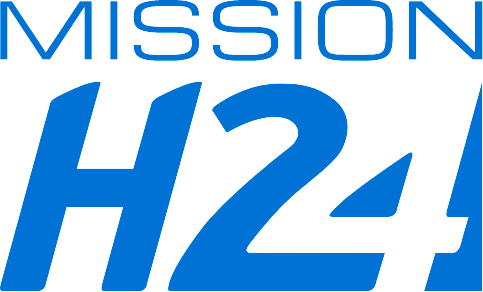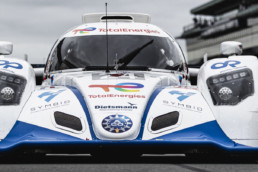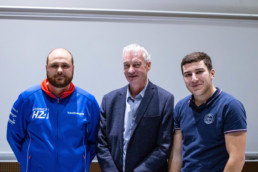The European Commission invites the H24 to Brussels
The European Commission has invited the H24, the electric-hydrogen prototype built under the MissionH24 programme, to appear at the Autoworld museum in Brussels on 1 March 2023.
After breaking new ground in sustainable mobility in 2022 by competing in – and finishing – Michelin Le Mans Cup races in Italy, France and Portugal, the zero-emission racing prototype will take part in an event in the Belgian capital in early March that will lay the foundations for European hydrogen strategy. The sporting programme is coupled with a real technological challenge to fuel the drive towards energy independence in Europe.
MissionH24, the joint initiative conducted by the Automobile Club de l’Ouest and GreenGT to introduce zero-carbon racing through a hydrogen class at the 24 Hours of Le Mans, will be represented at Autoworld, Brussels, on 1 March.
The celebrated Belgian museum will welcome the H24 prototype, the TotalEnergies mobile hydrogen station, a tank designed by Plastic Omnium to contain hydrogen gas, and a Symbio fuel cell. Along with Michelin, Richard Mille, Dietsmann and Essilor, these partners provide essential technical and strategic support for the programme.
This showcase will be an excellent opportunity for European institutions and the public to witness the complete ecosystem developed by MissionH24, which is now a fully functional, high-performance reality.
Racing drivers Stéphane Richelmi and Norman Nato will accompany the H24 which will sport its new livery for the 2023 season. This special colour scheme will pay tribute to the past and future of mobility and illustrate the convictions and aims of MissionH24 partners.
Make a date for 1 March 2023 when all will be revealed.
A cinema screening for the 24 Hours of Le Mans in Brussels
The screening of the official 2022 24 Hours of Le Mans film at TheMerode Club in Brussels on 28 February will be a great opportunity to meet the public, but also a chance to reflect on one of the most important aspects of the famous endurance race: the technological, industrial and economic challenge it represents for the automotive sector and for mobility as a whole. In 2023, the 24 Hours of Le Mans celebrates 100 years of history, 100 years of innovation.
Mariya Gabriel, European Commissioner for Innovation, Research, Culture, Education and Youth, and Pierre Fillon, president of the Automobile Club de l’Ouest, will be joined by racing drivers Sarah Bovy, Sébastien Buemi, Yannick Dalmas and Stéphane Richelmi to answer the audience’s questions after the screening.
They will no doubt address topics such as the energy transition and low-carbon transport, which are vital for our planet’s future.
MissionH24, the collaborative programme between the Automobile Club de l’Ouest and GreenGT, designed to promote hydrogen-fuelled racing, will be represented by Stéphane Richelmi. He drives the H24 prototype, which completed a series of races in 2022, and will be joined by other members of the H24Racing team. European Commissioner Mariya Gabriel will talk about her experience on the Bugatti circuit in Le Mans last March, when she was introduced to zero-emission hydrogen racing on board the LMPH2G, the first electric hydrogen prototype from MissionH24, alongside Richelmi. That was part of a day showcasing the hydrogen ecosystem developed by the Automobile Club de l’Ouest, Le Mans city council, La Sarthe department council and the Pays de la Loire regional council.
Just a few days ago, after a zero-emission drive through Paris between Place de la Concorde and the Eiffel Tower in MissionH24’s LMPH2G, the French Junior Minister for Industry Roland Lescure said:
Hydrogen is one of the keys to the energy transition and MissionH24 is a feat of innovation. As is often the case in the realm of the automobile, everything starts at the racetrack. It’s also a great pleasure to see that the names of the programme’s partners marked on the car’s body are those of French or European companies. This pioneering programme and this remarkable vehicle prompt us to think about how our lives will look in the future, as we move forward with a zero-carbon energy transition. This programme combines three aspects of French excellence: innovation, research and automotive engineering.
The screening at TheMerode Club on 28 February comes ahead of an important announcement on the European hydrogen strategy on 1 March in Brussels.
MissionH24 presents the Hydrogen Competition at ESTACA
Last December, the fuel cell, with Symbio, and the ACO's hydrogen strategy were the topics discussed during a first meeting with students from Estaca (Ecole Supérieure des Techniques Aéronautiques et de Construction Automobile) in Saint Quentin en Yvelines and those from Laval and Bordeaux, connected via videoconference. Hydrogen and the energy transition are obviously of great interest to this generation in training. Following this first appreciated exchange, a new intervention has been scheduled at the beginning of February.
MissionH24, a collaborative program between the Automobile Club de l'Ouest and GreenGT for the promotion of hydrogen in competition and the creation of a category dedicated to hydrogen prototypes at the 24 Hours of Le Mans, was represented this time by Bernard Niclot, ACO Hydrogen consultant and Antoine Larroque, operations engineer and team manager of H24Racing. The program of the day? The hydrogen competition. How do you introduce a new technology in a race? How to establish the sporting rules? What are the technical rules? What are the stages encountered by a pioneering race team, composed of mechanics and exploratory engineers? How was this electric hydrogen prototype welcomed on the track by the public and by the competitors?
Mentalities have evolved.
As Bernard Niclot and Antoine Larroque made their presentations, reminding us that the H24 fuel cell prototype had taken part in four Michelin Le Mans Cup events and had finished each of them by improving its performance on the track, the audience showed its curiosity by asking many questions.
What is the potential and reliability of a fuel cell? Why this type of chassis and aerodynamics? What will be the refueling time ? Where does the H24 stand in terms of performance compared to the thermal competition? What are the risks with hydrogen? What certifications are required to work in this high voltage context? What obstacles have been encountered? What is the development program? What improvements have you planned? What is your best memory? Imola, our first race in 2022, will remain my greatest achievement even if I have won races in my career," admitted Antoine Larroque. He added this anecdote: "On the races, I meet engineers from other teams with whom I went to school. At the beginning, they would tell me "I hope your machine won't break down often and cause us yellow or red flags." At the end of the weekend, they would sometimes come back and tell me, "so what did you do? I would reply that we had finished and learned. What about them? Their car could be on the board because it hadn't finished the race. Mentalities have evolved. We have shown that hydrogen in racing works and has potential. We are still at the beginning and learning because our technology is far from being mature like the combustion engine. It's exciting and virtuous for motorsport. Bernard Niclot emphasized this characteristic of racing and the 24 Hours of Le Mans, which celebrates its 100th anniversary in June: "Racing is a research laboratory for everyone's mobility. Hydrogen is part of its legendary contributions from the race to the road."





